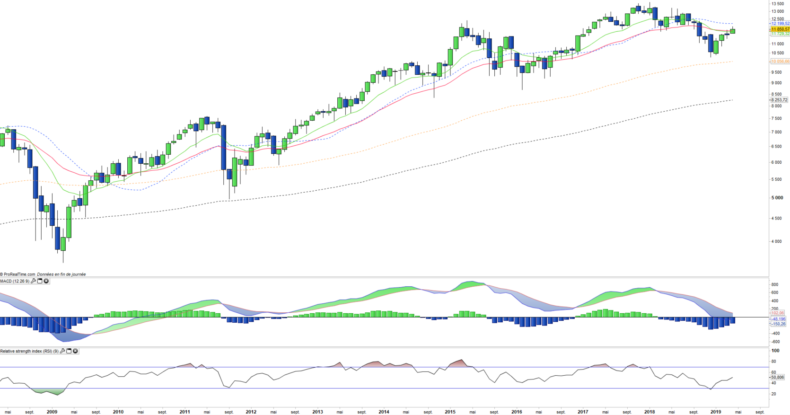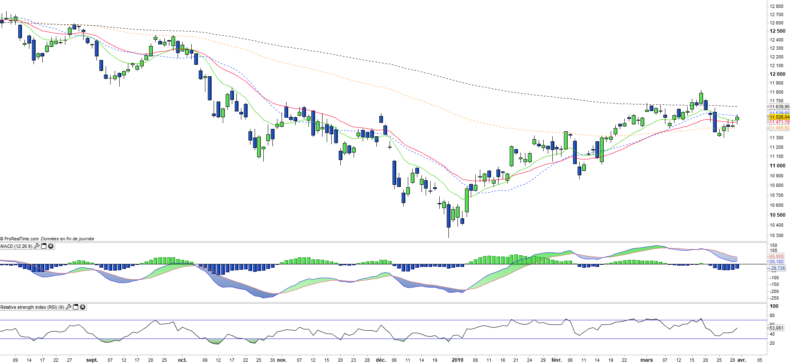DAX index - DAX - 09/04/19
Short Term trend: Positive (75/100)
Long Term trend: Positive (60/100)
(scores computed by our proprietary algorithms - cf methodology)
to access to our Buy / Sell signals
Index profile
The top 10 stocks are mainly large industrial stocks such as Siemens or Bayer, while there are only 2 financial stocks in the DAX: Allianz and Munchener Rueck, the German master index is relatively small and mostly composed of large industrial groups.
Unlike the English, French or Italian indices, the DAX is also distinguished by the absence of large oil companies that weigh heavily in the weighting of the CAC40, FTSE100 or FTSEMIB40, which is double-edged according to the cycle specific to energy sector.
In addition, the financials weigh only 16% of the index, half for the insurance giant Allianz, so the banking sector has a low weight reflected in the well-known weakness of Deutsche Bank and Commerzbank. Conversely, the automotive and chemical sectors are heavier than the other European indices, while the technology sector is mainly represented by SAP (10%) whose market capitalization exceeds € 100 billion.
In summary, the DAX is a fairly strong index from a sectoral point of view which can make it evolve differently from other European indices.
German fundamentals are very solid (historically low unemployment rate at 5.5% and accelerated deleveraging up to 2020). The main risks concern Germany's main customers, namely the United Kingdom, which could suffer from Brexit, the US in political uncertainty and threatening it with a trade war, Russia which remains a difficult and aggressive neighbor and China because of its commercial practices which also tend to limit access to its domestic market to Western industrialists, particularly in the automotive and technology sectors.
After an increase of 6.9% in 2016, the DAX30 grew by 12.5% in 2017, more than the stoxx600 (+ 10.6%). But the index fell by 18.5% in 2018, which is a much lower performance than the Stoxx600NR (-10.7%). The DAX starts a rebound since the beginning of the year (+ 9.2%) which seems very fragile in comparison with other european indexes. This poor performance reflects the large share of cyclical stocks (chemicals, autos, equipment goods) in the index and the exposure to international trade endangered by the US protectionist attitude and fears over the Chinese growth on which German companies are increasingly dependent.
The weakening of the Chinese economy and in particular the automotive sector is a matter of concern for the German industry, which is almost in recession.
Instruments : DBX (DB x-Tracker en Euro), DAXEX (iShares en Euro), DAX (Lyxor en Euro)
Technical analysis
Monthly analysis
On the monthly chart we can see a reversal signal underway with the April candlestick going back over the EMAS13 and 26 and beginning the recovery of the uptrend. This upward push is also reflected in the outperformance of the index over the past week, which has not happened for a long time. A bullish crossover of the EMAs12 & 26 could move quickly if prices manage to stay at current levels.
Weekly analysis
The weekly chart shows the reversal that has just occurred in the medium term. The DAX has simultaneously invalidated the bearish line active since the beginning of 2018, then crossed all rising moving averages, including the EMA100, which had hitherto served as resistance. Confirmation of the signal comes with the crossing of the EMAs12 / 26, which now places the index in a bullish medium-term. The DAX should now catch up on other stock markets over the next few weeks.
Country breakdown
| Germany | 100% |
Sector breakdown
| Materials | 18% |
| Consumer discretionary | 16% |
| Financials | 16% |
| Information technology | 14% |
| Industrials | 12% |
| Health Care | 11% |
| Communication services | 5% |
| Others | 8% |
Top Ten Holdings
| SAP | 10% |
| Allianz | 9% |
| Linde | 9% |
| Siemens | 8% |
| BASF | 6% |
| Bayer | 6% |
| Daimler | 5% |
| Deutsche Telekom | 5% |
| Adidas | 4% |
| Muenchener Rueckver | 3% |


